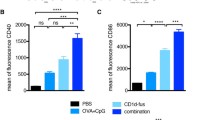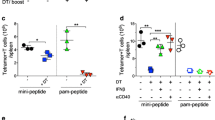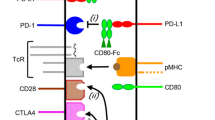Abstract
We have demonstrated that coupling an immunoregulatory segment of the MHC class II-associated invariant chain (Ii), the Ii-Key peptide, to a promiscuous MHC class II epitope significantly enhances its presentation to CD4+ T cells. Here, a series of homologous Ii-Key/HER-2/neu(776-90) hybrid peptides, varying systematically in the length of the epitope(s)-containing segment, are significantly more potent than the native peptide in assays using T cells from patients with various types of tumors overexpressing HER-2/neu. In particular, priming normal donor and patient PBMCs with Ii-Key hybrid peptides enhances recognition of the native peptide either pulsed onto autologous dendritic cells (DCs) or naturally presented by IFN-γ-treated autologous tumor cells. Moreover, patient-derived CD4+ T cells primed with the hybrid peptides provide a significantly stronger helper effect to autologous CD8+ T cells specific for the HER-2/neu(435-43) CTL epitope, as illustrated by either IFN-γ ELISPOT assays or specific autologous tumor cell lysis. Hybrid peptide-specific CD4+ T cells strongly enhanced the antitumor efficacy of HER-2/neu(435-43) peptide-specific CTL in the therapy of xenografted SCID mice inoculated with HER-2/neu overexpressing human tumor cell lines. Our data indicate that the promiscuously presented vaccine peptide HER-2/neu(776-90) is amenable to Ii-Key-enhancing effects and supports the therapeutic potential of vaccinating patients with HER-2/neu+ tumors with such Ii-Key/HER-2/neu(776-90) hybrid peptides.






Similar content being viewed by others
References
Adams S, Albericio F, Alsina J, Smith ER, Humphreys RE (1997) Biological activity and therapeutic potential of homologs of an Ii peptide which regulates antigenic peptide binding to cell surface MHC class II molecules. Arzneimittelforschung 47:1069–1077
Adams S, Humphreys RE (1995) Invariant chain peptides enhancing or inhibiting the presentation of antigenic peptides by major histocompatibility complex class II molecules. Eur J Immunol 25:1693–1702
Antonia S, Mule JJ, Weber JS (2004) Current developments of immunotherapy in the clinic. Curr Opin Immunol 16:130–136
Baumgaertner P, Rufer N, Devevre E, Derre L, Rimoldi D, Geldhof C, Voelter V, Lienard D, Romero P, Speiser DE (2006) Ex vivo detectable human CD8 T-cell responses to cancer-testis antigens. Cancer Res 66:1912–1916
Baxevanis CN, Dedoussis GV, Gritzapis AD, Stathopoulos GP, Papamichail M (1994) Interleukin 1 beta synergises with interleukin 2 in the outgrowth of autologous tumour-reactive CD8 + effectors. Br J Cancer 70:625–630
Baxevanis CN, Dedoussis GV, Papadopoulos NG, Missitzis I, Stathopoulos GP, Papamichail M (1994) Tumor specific cytolysis by tumor infiltrating lymphocytes in breast cancer. Cancer 74:1275–1282
Baxevanis CN, Sotiropoulou PA, Sotiriadou NN, Papamichail M (2004) Immunobiology of HER-2/neu oncoprotein and its potential application in cancer immunotherapy. Cancer Immunol Immunother 53:166–175
Baxevanis CN, Voutsas IF, Tsitsilonis OE, Gritzapis AD, Sotiriadou R, Papamichail M (2000) Tumor-specific CD4+ T lymphocytes from cancer patients are required for optimal induction of cytotoxic T cells against the autologous tumor. J Immunol 164:3902–3912
Bennett SR, Carbone FR, Karamalis F, Flavell RA, Miller JF, Heath WR (1998) Help for cytotoxic-T-cell responses is mediated by CD40 signalling. Nature 393:478–480
Berger U, Wilson P, Thethi S, McClelland RA, Greene GL, Coombes RC (1989) Comparison of an immunocytochemical assay for progesterone receptor with a biochemical method of measurement and immunocytochemical examination of the relationship between progesterone and estrogen receptors. Cancer Res 49:5176–5179
Bourgeois C, Rocha B, Tanchot C (2002) A role for CD40 expression on CD8+ T cells in the generation of CD8+ T cell memory. Science 297:2060–2063
Brinkman JA, Fausch SC, Weber JS, Kast WM (2004) Peptide-based vaccines for cancer immunotherapy. Expert Opin Biol Ther 4:181–198
Carlo ED, Cappello P, Sorrentino C, D’Antuono T, Pellicciotta A, Giovarelli M, Forni G, Musiani P, Triebel F (2005) Immunological mechanisms elicited at the tumour site by lymphocyte activation gene-3 (LAG-3) versus IL-12: sharing a common Th1 anti-tumor immune pathway. J Pathol 205:82–91
Casares N, Lasarte JJ, Lopez-Diaz de Cerio, Sardoe P, Ruiz M, Melevo I, Prieto J, Borras-Cuesta F (2001) Immunization with a tumor associated epitope plus a tumor-related or unrelated Th-helper peptide, elicits protective CTL immunity. Eur J Immunol 31:1780–1789
Chen YQ, Shi HZ, Qin XJ, Mo WN, Liang XD, Huang ZX, Yang HB, Wu C (2005) CD4+ CD25+ regulatory T lymphocytes in malignant pleural effusion. Am J Respir Crit Care Med 172:1434–1439
Fisk B, Hudson JM, Kavanagh J, Wharton JT, Murray JL, Ioannides CG, Kudelka AP (1997) Existent proliferative responses of peripheral blood mononuclear cells from healthy donors and ovarian cancer patients to HER-2 peptides. Anticancer Res 17:45–53
Gao FG, Khammanivong V, Liu WJ, Leggatt GR, Frazer IH, Fernando GJ (2002) Antigen-specific CD4+ T cell help is required to activate a memory CD8+ T cell to a fully functional tumor-killer cell. Cancer Res 62:6438–6441
Gillogly ME, Kallinteris NL, Xu M, Gulfo JV, Humphreys RE, Murray JL (2004) Ii-Key/HER-2/neu MHC class-II antigenic epitope vaccine peptide for breast cancer. Cancer Immunol Immunother 53:490–496
Gritzapis AD, Mahaira LG, Perez SA, Cacoullos NT, Papamichail M, Baxevanis CN (2006) Vaccination with human HER-2/neu(435-43) cytotoxic T lymphocyte peptide induces effective antitumor immunity against HER-2/neu expressing tumor cells in vivo. Cancer Res 66:5452–5460
Gritzapis AD, Sotiriadou NN, Papamichail M, Baxevanis CN (2004) Generation of human tumor-specific CTLs in HLA-A2.1-transgenic mice using unfractionated peptides from eluates of human primary breast and ovarian tumors. Cancer Immunol Immunother 53:1027–1040
Humphreys RE, Adams S, Koldzic G, Nedelescu B, von Hofe E, Xu M (2000) Increasing the potency of MHC class II-presented epitopes by linkage to Ii-Key peptide. Vaccine 18:2693–2697
Jager E, Jager D, Karbach J, Chen YT, Ritter G, Nagata Y, Gnjatic S, Stockert E, Arand M, Old LJ, Knuth A (2000) Identification of NY-ESO-1 epitopes presented by human histocompatibility antigen (HLA)-DRB4*0101-103 and recognized by CD4(+) T lymphocytes of patients with NY-ESO-1-expressing melanoma. J Exp Med 191:625–630
Kallinteris NL, Lu X, Wu S, Hu H, Li Y, Gulfo JV, Humphreys RE, Xu M (2003) Ii-Key/MHC class II epitope hybrid peptide vaccines for HIV. Vaccine 21:4128–4132
Kallinteris NL, Powell D, Blackwell CE, Kim M, Lu X, Wu S, Humphreys RE, Xu M, Von Hofe E (2006) Ii-Key/MHC class II epitope peptides as helper T cell vaccines for cancer and infectious disease. Frontiers in Bioscience:46-8
Kallinteris NL, Wu S, Lu X, Humphreys RE, von Hofe E, Xu M (2005) Enhanced CD4+ T-cell response in DR4-transgenic mice to a hybrid peptide linking the Ii-Key segment of the invariant chain to the melanoma gp100(48-8) MHC class II epitope. J Immunother 28:352–358
Kaufmann DE, Bailey PM, Sidney J, Wagner B, Norris PJ, Johnston MN, Cosimi LA, Addo MM, Lichterfeld M, Altfeld M, Frahm N, Brander C, Sette A, Walker BD, Rosenberg ES (2004) Comprehensive analysis of human immunodeficiency virus type 1-specific CD4 responses reveals marked immunodominance of gag and nef and the presence of broadly recognized peptides. J Virol 78:4463–4477
Kawashima I, Hudson SJ, Tsai V, Southwood S, Takesako K, Appella E, Sette A, Celis E (1998) The multi-epitope approach for immunotherapy for cancer: identification of several CTL epitopes from various tumor-associated antigens expressed on solid epithelial tumors. Hum Immunol 59:1–14
Kiessling A, Schmitz M, Stevanovic S, Weigle B, Holig K, Fussel M, Fussel S, Meye A, Wirth MP, Rieber EP (2002) Prostate stem cell antigen: Identification of immunogenic peptides and assessment of reactive CD8+ T cells in prostate cancer patients. Int J Cancer 102:390–397
Knutson KL, Disis ML (2005) Tumor antigen-specific T helper cells in cancer immunity and immunotherapy. Cancer Immunol Immunother 54:721–728
Knutson KL, Schiffman K, Disis ML (2001) Immunization with a HER-2/neu helper peptide vaccine generates HER-2/neu CD8 T-cell immunity in cancer patients. J Clin Invest 107:477–484
Kuball J, Schmitz FW, Voss RH, Ferreira EA, Engel R, Guillaume P, Strand S, Romero P, Huber C, Sherman LA, Theobald M (2005) Cooperation of human tumor-reactive CD4+ and CD8+ T cells after redirection of their specificity by a high-affinity p53A2.1-specific TCR. Immunity 22:117–129
Lee TV, Johnston DA, Thomakos N, Honda T, Efferson CL, Ioannides CG (2002) Helper peptide G89 (HER-2:777-89) and G89-activated cells regulate the survival of effectors induced by the CTL epitope E75 (HER-2, 369-77). Correlation with the IFN-gamma: IL-10 balance. Anticancer Res 22:1481–1490
Lu S, Reyes VE, Lew RA, Anderson J, Mole J, Humphreys RE, Ciardelli T (1990) Role of recurrent hydrophobic residues in catalysis of helix formation by T cell-presented peptides in the presence of lipid vesicles. J Immunol 145:899–904
Marzo AL, Kinnear BF, Lake RA, Frelinger JJ, Collins EJ, Robinson BW, Scott B (2000) Tumor-specific CD4+ T cells have a major “post-licensing-role in CTL mediated anti-tumor immunity. J Immunol 165:6047–6055
Mittendorf EA, Storrer CE, Shriver CD, Ponniah S, Peoples GE (2005) Evaluation of the CD107 cytotoxicity assay for the detection of cytolytic CD8+ cells recognizing HER2/neu vaccine peptides. Breast Cancer Res Treat 92:85–93
Paczesny S, Banchereau J, Wittkowski KM, Saracino G, Fay J, Palucka AK (2004) Expansion of melanoma-specific cytolytic CD8+ T cell precursors in patients with metastatic melanoma vaccinated with CD34+ progenitor-derived dendritic cells. J Exp Med 199:1503–1511
Perez SA, Sotiropoulou PA, Sotiriadou NN, Mamalaki A, Gritzapis AD, Echner H, Voelter W, Pawelec G, Papamichail M, Baxevanis CN (2002) HER-2/neu-derived peptide 884-99 is expressed by human breast, colorectal and pancreatic adenocarcinomas and is recognized by in-vitro-induced specific CD4(+) T cell clones. Cancer Immunol Immunother 50:615–624
Rentzsch C, Kayser S, Stumm S, Watermann I, Walter S, Stevanovic S, Wallwiener D, Guckel B (2003) Evaluation of pre-existent immunity in patients with primary breast cancer: molecular and cellular assays to quantify antigen-specific T lymphocytes in peripheral blood mononuclear cells. Clin Cancer Res 9:4376–4386
Ridge JP, Di Rosa F, Matzinger P (1998) A conditioned dendritic cell can be a temporal bridge between a CD4+ T-helper and a T-killer cell. Nature 393: 474–478
Rongcun Y, Salazar-Onfray F, Charo J, Malmberg KJ, Evrin K, Maes H, Kono K, Hising C, Petersson M, Larsson O, Lan L, Appella E, Sette A, Celis E, Kiessling R (1999) Identification of new HER2/neu-derived peptide epitopes that can elicit specific CTL against autologous and allogeneic carcinomas and melanomas. J Immunol 163:1037–1044
Salazar LG, Fikes J, Southwood S, Ishioka G, Knutson KL, Gooley TA, Schiffman K, Disis ML (2003) Immunization of cancer patients with HER-2/neu-derived peptides demonstrating high-affinity binding to multiple class II alleles. Clin Cancer Res 9:5559–5565
Schnell S, Young JW, Houghton AN, Sadelain M (2000) Retrovirally transduced mouse dendritic cells require CD4+ T cell help to elicit antitumor immunity: implications for the clinical use of dendritic cells. J Immunol 164:1243–1250
Schoenberger SP, Toes RE, van der Voort EI, Offringa R, Melief CJ (1998) T-cell help for cytotoxic T lymphocytes is mediated by CD40-CD40L interactions. Nature 393:480–483
Sotiriadou R, Perez SA, Gritzapis AD, Sotiropoulou PA, Echner H, Heinzel S, Mamalaki A, Pawelec G, Voelter W, Baxevanis CN, Papamichail M (2001) Peptide HER2(776-88) represents a naturally processed broad MHC class II-restricted T cell epitope. Br J Cancer 85:1527–1534
Sotiropoulou PA, Perez SA, Voelter V, Echner H, Missitzis I, Tsavaris NB, Papamichail M, Baxevanis CN (2003) Natural CD8+ T-cell responses against MHC class I epitopes of the HER-2/ neu oncoprotein in patients with epithelial tumors. Cancer Immunol Immunother 52:771–779
Tuttle TM, Anderson BW, Thompson WE, Lee JE, Sahin A, Smith TL, Grabstein KH, Wharton JT, Ioannides CG, Murray JL (1998) Proliferative and cytokine responses to class II HER-2/neu-associated peptides in breast cancer patients. Clin Cancer Res 4:2015–2024
Wang RF (1999) Human tumor antigens: implications for cancer vaccine development. J Mol Med 77:640–655
Wang L, Miyahara Y, Kato T, Wang L, Aota T, Kuribayashi K, Shiku H (2003) Essential roles of tumor-derived helper T cell epitopes for an effective peptide-based tumor vaccine. Cancer Immunity 3:16–29
Wang RF, Rosenberg SA (1999) Human tumor antigens for cancer vaccine development. Immunol Rev 170:85–100
Wolf AM, Wolf D, Steurer M, Gastl G, Gunsilius E, Grubeck-Loebenstein B (2003) Increase of regulatory T cells in the peripheral blood of cancer patients. Clin Cancer Res 9:606–612
Xu M, Capraro GA, Daibata M, Reyes VE, Humphreys RE (1994) Cathepsin B cleavage and release of invariant chain from MHC class II molecules follow a staged pattern. Mol Immunol 31:723–731
Xu M, Jackson R, Adams S, Humphreys RE (1999) Studies on activities of invariant chain peptides on releasing or exchanging of antigenic peptides at human leukocyte antigen-DR1. Arzneimittelforschung 49:791–799
Yannelli JR, Wroblewski JM (2004) On the road to a tumor cell vaccine: 20 years of cellular immunotherapy. Vaccine 23:97–113
Zaks TZ, Rosenberg SA (1998) Immunization with a peptide epitope (p369-77) from HER-2/neu leads to peptide-specific cytotoxic T lymphocytes that fail to recognize HER-2/neu+ tumors. Cancer Res 58:4902–4908
Author information
Authors and Affiliations
Corresponding author
Additional information
Nectaria N. Sotiriadou and Nikoletta L. Kallinteris have contributed equally to the work.
Rights and permissions
About this article
Cite this article
Sotiriadou, N.N., Kallinteris, N.L., Gritzapis, A.D. et al. Ii-Key/HER-2/neu(776-90) hybrid peptides induce more effective immunological responses over the native peptide in lymphocyte cultures from patients with HER-2/neu+ tumors. Cancer Immunol Immunother 56, 601–613 (2007). https://doi.org/10.1007/s00262-006-0213-z
Received:
Accepted:
Published:
Issue Date:
DOI: https://doi.org/10.1007/s00262-006-0213-z




